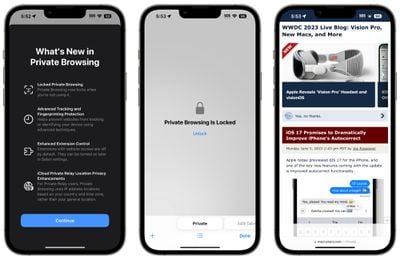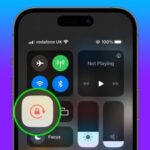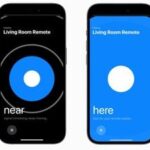iOS 17 Lock your Safari private browsing behind Face ID
Apple is enhancing the security of Safari in iOS 17, and private browsing now requires Face ID authentication or a password to access. If you open a private browsing window in Safari, you need to authenticate using Face ID.

This means that someone with access to your unlocked phone and opening your Safari browser will not be able to access your private browsing history without secondary authentication. Face ID or a password can be used to access Safari private tabs.
Private Browsing also improves privacy by completely preventing known trackers from loading on pages and removing tracking that is added to URLs as you browse. With these new features, websites can't track or identify your device, and Apple provides improved extension controls.
In private mode, extensions with website access are turned off and you need to manually re-enable them. iCloud Private Proxy also uses IP address location based on country and time zone instead of regular location.
Safari in iOS 17 also gets the profile feature, so you can separate personal browsing and work browsing, with different history, tab groups, cookies, and favorites.
Related Articles
-

What is “App Network Activity” on iPhone in iOS 15?
What is application network activity? App network activity is Apple's way of telling you which domains have been contacted by apps installed on your system in the past. When you use an application, it connects to the Internet and shares information within its internal domains as well as other third-party domains. These external domains can...
-

#Apple seeds first beta of watchOS 10 to developers
Apple has seeded the first beta of watchOS 10 to developers, which will be available soon. The first beta version of the watchOS 10 update, used for testing purposes. To install the watchOS 10 update, developers need to open the Apple Watch app, go to the Software Update section under General in Settings, and open watchOS…
-

Apple releases the first beta versions of iOS 17 and iPadOS 17
Apple has released the first beta versions of iOS 17 and iPadOS 17 to developers for testing purposes. The beta is only available to those with developer accounts, and Apple is limiting downloads by doing away with the previous profile system. Registered developers can do so by opening the Settings app and going to...
-

Apple releases first beta version of macOS 14 Sonoma to developers
Apple today released the first beta version of the newly announced macOS 14 Sonoma update to developers for testing purposes. While the beta is currently limited to developers, Apple plans to offer a public beta later this summer. Registered developers can download it through the Apple Developer Center...
The above is the detailed content of iOS 17 Lock your Safari private browsing behind Face ID. For more information, please follow other related articles on the PHP Chinese website!

Hot AI Tools

Undresser.AI Undress
AI-powered app for creating realistic nude photos

AI Clothes Remover
Online AI tool for removing clothes from photos.

Undress AI Tool
Undress images for free

Clothoff.io
AI clothes remover

Video Face Swap
Swap faces in any video effortlessly with our completely free AI face swap tool!

Hot Article

Hot Tools

Notepad++7.3.1
Easy-to-use and free code editor

SublimeText3 Chinese version
Chinese version, very easy to use

Zend Studio 13.0.1
Powerful PHP integrated development environment

Dreamweaver CS6
Visual web development tools

SublimeText3 Mac version
God-level code editing software (SublimeText3)

Hot Topics
 1387
1387
 52
52
 How to turn off private browsing authentication for iPhone in Safari?
Nov 29, 2023 pm 11:21 PM
How to turn off private browsing authentication for iPhone in Safari?
Nov 29, 2023 pm 11:21 PM
In iOS 17, Apple introduced several new privacy and security features to its mobile operating system, one of which is the ability to require two-step authentication for private browsing tabs in Safari. Here's how it works and how to turn it off. On an iPhone or iPad running iOS 17 or iPadOS 17, Apple's browser now requires Face ID/Touch ID authentication or a passcode if you have any Private Browsing tab open in Safari and then exit the session or app to access them again. In other words, if someone gets their hands on your iPhone or iPad while it's unlocked, they still won't be able to view your privacy without knowing your passcode
 How to disable private browsing authentication in Safari: How-to guide for iOS 17
Sep 11, 2023 pm 06:37 PM
How to disable private browsing authentication in Safari: How-to guide for iOS 17
Sep 11, 2023 pm 06:37 PM
In iOS 17, Apple introduced several new privacy and security features to its mobile operating system, one of which is the ability to require two-step authentication for private browsing tabs in Safari. Here's how it works and how to turn it off. On an iPhone or iPad running iOS 17 or iPadOS 17, if you have any Private Browsing tab open in Safari and then exit the session or app, Apple's browser now requires Face ID/TouchID authentication or a passcode to access again they. In other words, if someone gets their hands on your iPhone or iPad while it's unlocked, they still won't be able to view it without knowing your passcode
 How to implement single sign-on in PHP
Jun 11, 2023 pm 07:01 PM
How to implement single sign-on in PHP
Jun 11, 2023 pm 07:01 PM
Single sign-on (SSO) is an authentication mechanism that allows users to authenticate across multiple applications and sites using a single set of credentials, such as a username and password. This mechanism can improve user experience and efficiency while also enhancing security. In PHP, implementing single sign-on requires some specific methods. Below we will introduce how to implement single sign-on in PHP. We will divide it into the following steps: Create a user authentication center (AuthenticationCenter) using OAuth2
 Face ID invalid after iOS16 upgrade? Here are 4 solutions to help you restore the usability of Face ID!
Jan 10, 2024 pm 10:57 PM
Face ID invalid after iOS16 upgrade? Here are 4 solutions to help you restore the usability of Face ID!
Jan 10, 2024 pm 10:57 PM
Recently, many users in the Apple community have reported that their iPhones cannot use FaceID after upgrading to iOS16. When they try to reset FaceID, the system will pop up a prompt box saying "Face ID is not available, please try setting up Face ID later." If a pop-up window appears on your iPhone, but it has not been dropped or soaked in water, Then it is likely that there is an error in the system software. In this case, you can try the following methods to solve the problem: 1. Try to restart the iPhone. When using the iPhone system, you sometimes encounter some temporary problems, which are often called BUGs. Fortunately, however, fixing these issues is usually as simple as restarting your device.
 Implementing user authentication using middleware in the Slim framework
Jul 29, 2023 am 10:22 AM
Implementing user authentication using middleware in the Slim framework
Jul 29, 2023 am 10:22 AM
Implementing user authentication using middleware in the Slim framework With the development of web applications, user authentication has become a crucial feature. In order to protect users' personal information and sensitive data, we need a reliable method to verify the user's identity. In this article, we will introduce how to implement user authentication using the Slim framework’s middleware. The Slim framework is a lightweight PHP framework that provides a simple and fast way to build web applications. One of the powerful features is the middle
 Token-based authentication with Angular and Node
Sep 01, 2023 pm 02:01 PM
Token-based authentication with Angular and Node
Sep 01, 2023 pm 02:01 PM
Authentication is one of the most important parts of any web application. This tutorial discusses token-based authentication systems and how they differ from traditional login systems. By the end of this tutorial, you will see a fully working demo written in Angular and Node.js. Traditional Authentication Systems Before moving on to token-based authentication systems, let’s take a look at traditional authentication systems. The user provides their username and password in the login form and clicks Login. After making the request, authenticate the user on the backend by querying the database. If the request is valid, a session is created using the user information obtained from the database, and the session information is returned in the response header so that the session ID is stored in the browser. Provides access to applications subject to
 How to reset Apple ID password?
May 21, 2023 pm 05:01 PM
How to reset Apple ID password?
May 21, 2023 pm 05:01 PM
How to reset Apple ID password? If you forgot your AppleID password, don't worry. You can easily reset it using one of the following methods. Using your iPhone or other trusted Apple device is the fastest and easiest way to reset your password, as long as you have the device signed in with your Apple ID. Go to Settings and tap your name. Click Password & Security, then click Change Password. Follow the on-screen instructions to create a new password. Apple You can also use this method on a trusted iPad, iPod touch, or Apple Watch. Use the Apple Support App If you don't have an Apple device but have access to a trusted phone number, you can get a call from a friend or
 Laravel development: How to manage user authentication with Laravel Guard?
Jun 13, 2023 pm 04:41 PM
Laravel development: How to manage user authentication with Laravel Guard?
Jun 13, 2023 pm 04:41 PM
Laravel development: How to manage user authentication with LaravelGuard? In web applications, security and user authentication are crucial. As your business grows, so does the number of users, and without a good user authentication scheme implemented, your application can be vulnerable to a variety of attacks, including malicious attacks, data leaks, and other security issues. Fortunately, the Laravel framework provides a simple yet effective way to handle user authentication. This method is called Gu







